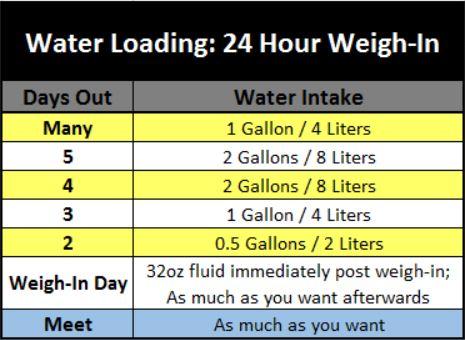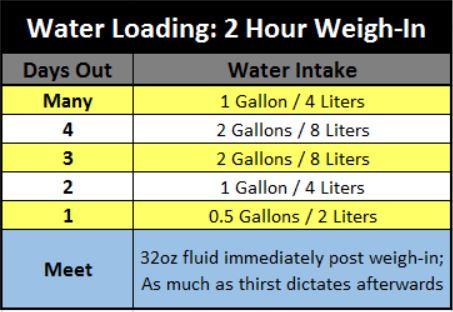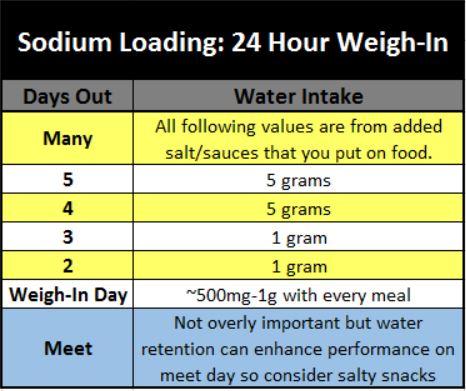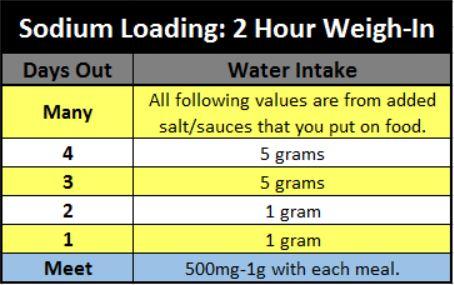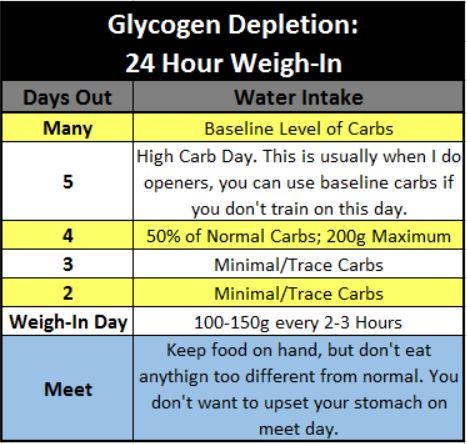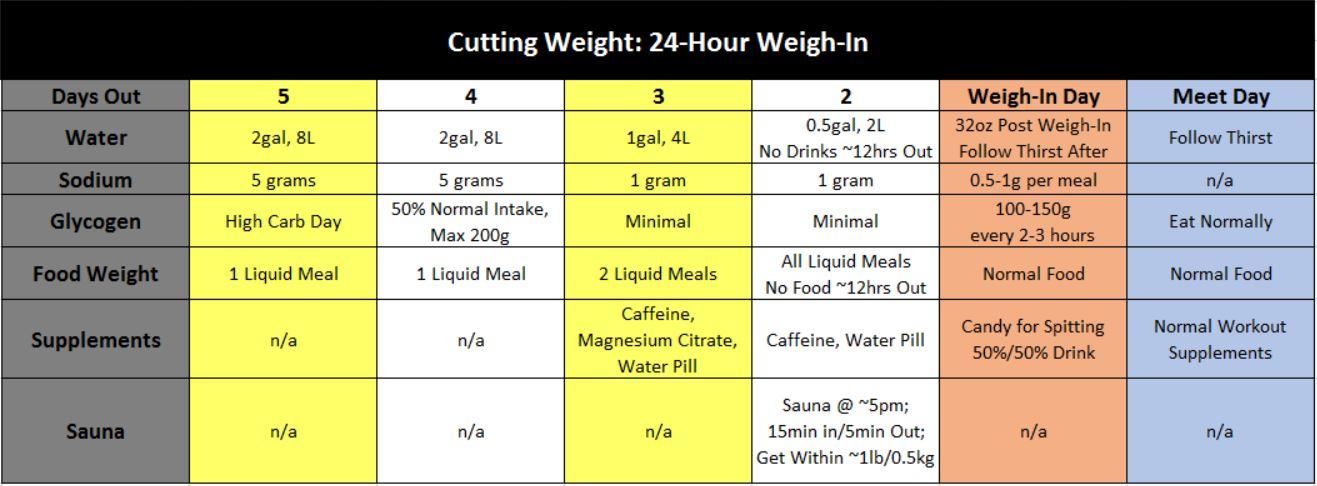Let’s talk about how to cut weight for powerlifting!
In the last article in the nutrition series, we discussed when to move up a weight class. If you’ll recall, our rule for deciding what weight class to compete in was: the lowest possible weight class without crossing below our minimum body fat threshold and without cutting more than 5-10% water weight depending on the length of our weigh-ins.
In this article, we’re going to bring the final piece of the puzzle together and figure out how to actually cut water weight for a meet – both for 2-hour weigh-ins and 24-hour weigh-ins.
There are a whole variety of aspects to consider when of water cutting to make weight for a meet: 1) water intake manipulation, 2) sodium manipulation, 3) glycogen manipulation, 4) food weight manipulation, 5) supplements, 6) dehydration tactics, and 7) reconstitution.
Please keep in mind that, as a general rule, the less of these tactics that you have to use to make weight, the better your chances will be of maintaining or increasing performance on meet day.
If you’d rather watch than read:
Water Intake Manipulation
Many of the practices that we’re going to engage in involve ramping up some of the body’s compensation mechanisms. Water manipulation is really no different.
The primary method of water manipulation is a tried and true practice called “water loading”. Water loading simply involves overhydrating yourself for a few days so that your body’s regulatory mechanisms kick into high gear and start excreting water at an accelerated pace.
Once this is happening, we’ll drastically cut back on water. Now, the body will eventually compensate for this, but there is a delay period. In other words, when you initially cut back on water consumption, after overconsuming, your body will continue to expel water at an accelerated pace. In simple terms, you’ll keep pissing like you’re consuming a ton of water, but you simply won’t be taking in a bunch of water anymore.
Keep in mind that this practice only works if you’re already consuming an adequate amount of water when you begin the process. If you haven’t been drinking enough water in the weeks leading up to the weight cut, this won’t work.
Let’s see what it looks like in practice.
How to Water Load
The following assumes you’ve been consuming ~1 gallon / ~4 liters of water per day in the weeks leading up to the meet.
Water Loading for a 24 Hour Weigh In
Note: Quit drinking water ~12 hours before your weigh-in time.
More on Weigh-In Day:
a) Immediately drink 32oz of fluids made of 50% water and 50% gatorade, pedialyte or coconut water
b) Drink as much water as you’d like. You’ll need to put a lot of water back on and, if you rush the process, you’ll get sick. This is very individual. Go at your own pace in terms of the water.
Meet Day:
I’d recommend sipping on the same aforementioned 50%/50% concoction described above. Just make sure you meet your hydration needs. We’ll discuss Meet Day nutrition more elsewhere.
Water Loading for a 2 Hour Weigh In
Note: Quit drinking water ~12 hours before your weigh-in time.
Meet Day, Post Weigh-Ins:
a) Immediately drink 32oz of fluids made of 50% water and 50% gatorade, pedialyte or coconut water
b) Continue drinking this concoction throughout the meet.
Meet Day, Lifting:
Continue to drink water as thirst dictates.
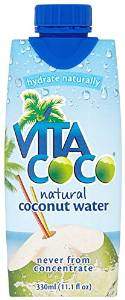
Coconut water is my preferred fluid to mix with water for reconstitution purposes.
Sodium Manipulation
Sodium manipulation works in nearly exactly the same fashion as water manipulation. You’re going to need a baseline level of sodium intake so that your body is already used to processing and dealing with salt. Then, you’re going to radically increase your intake for a short period which is going to cause temporary water retention especially alongside the extra water you’ll be drinking. This causes your body to kick into high gear as far as dealing with sodium goes. A few days out from the meet, you’ll cut out most of your sodium and, due to the delayed effect on your body’s regulatory mechanisms, you’ll dump out a lot more water than usual.
Let’s take a look at how it might play out in practice.
How to Manipulate Sodium
The following assumes that you’ve already been adding sodium to your foods in the preceding weeks via sauces and table salt.
Sodium Manipulation for a 24 Hour Weigh In
Sodium Manipulation for a 2 Hour Weigh In
Carbohydrate Intake Manipulation
Carb manipulation actually works differently than our previous forays into water and salt manipulation, respectively. You see, in order to store each gram of glycogen in your muscular stores, approximately 4g of water is required as well. Depending on the size your body, you might be capable of storing anywhere from 400-800g of glycogen or more. If you’re following along, this means that approximately ~2kg-4kg (~4.5lbs-9lbs) of your body weight is made up of glycogen and the water that is requisite to its storage. In fact, large male athletes often see even bigger losses than this when they’re fully glycogen depleted.
Now, carbohydrate manipulation takes a bit of finesse because it is context dependent. If you have a 24-hour weigh-in, you’ll often have plenty of time to completely deplete your glycogen stores for the weigh-in and then (nearly) completely replenish them by the time the meet starts.
However, if you’re a 2-hour weigh-in athlete, you absolutely will not have time to do this. Depending on how large you are, you might be capable of reconstituting anywhere from 50g-100g every two hours. In other words, you cannot completely deplete your glycogen stores and then completely replenish them in time for the meet.
In fact, depending on the size of the weight cut, you might not want to mess with glycogen manipulation at all as a 2-hour weigh-in athlete. Water loading and sodium manipulation alone are often enough to produce 1-3kg (~2-6lbs) of transient weight loss depending on how large of a human being you are. As a 2-hour weigh-in athlete, if you can avoid doing so, I wouldn’t deplete glycogen too much. If you have no other choice in order to make weight, well, you have no other choice.
For two 2 hour weigh in athletes, I’m going to be presenting a partial depletion option here, but please keep in mind that even this option is going to be fairly drastic and might cause a dent in your performance. Remember the general rule: the fewer tactics you have to use to make weight, the better your chances of maintaining performance.
Glycogen Depletion for 24 Hour Weigh In
Weigh-In Day, Post Weigh-In:
Eat ~100g-150g of carbs every 2-3 hours. Keep fat to ~10g per meal initially because it will blunt the rate of digestion and thus absorption. Fat can increase somewhat towards the end of the day. Do NOT eat foods that are significantly different than usual. Your stomach is in a fragile state.
Meet Day:
There is no particular carbohydrate recommendation that I’m going make for the meet itself. Keep snacks on hand, don’t eat foods too different from usual, and eat relatively normally. Keep your 50%/50% drink on hand and sip that for additional carbohydrates.
Glycogen Depletion for 2 Hour Weigh In
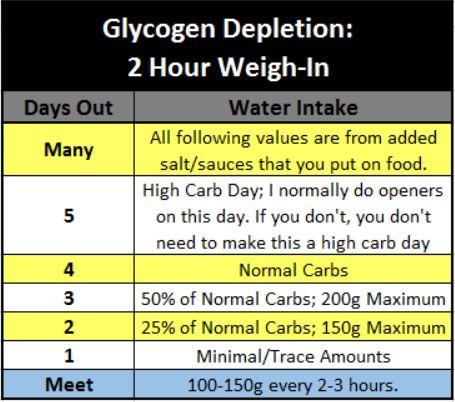
Meet Day, Post Weigh-In: Eat ~100g of carbs every 2 hours. Keep fat to ~10g per meal initially because it will blunt the rate of digestion and thus absorption. You’re going to have to keep the fat low until towards the end of the meet. You need to maximize the rate of glycogen resynthesis.
Food Weight Manipulation
One of the most underlooked aspects of cutting weight is perhaps the fact that food itself has a weight. You don’t want to waste pounds or kilos on the scale because you still have food digesting in your system. There are two ways to prevent this: a) liquid meals and b) taking a laxative at some point. I tend to recommend both in concert for best effect. I consider laxatives a supplement so we’ll just address the liquid meals in this section. This is another easy way to take-off weight without directly affecting your performance.
Starting about 4-5 days out, I recommend making one of your meals liquid. This is very simple to do. You’re going to need a whey protein powder supplement and perhaps some milk for flavoring. That is all it takes. You can add additional carbohydrates through waxy maize, dextrose, or some other carbohydrate product if necessary. Make the liquid meal the last meal of the day so you can start to get a sense of how it is going to impact your weight throughout the week.
Let’s look at a sample template.
How to Manipulate Food Weight
Manipulating Food for a 24 Hour Weigh-In
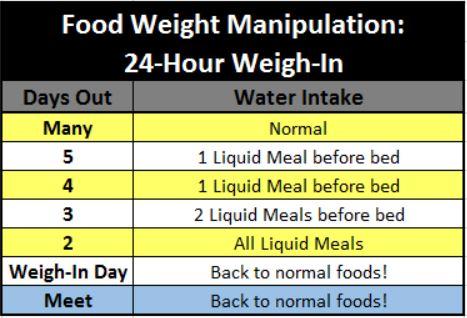
Note: Quit eating ~12 hours before your weigh-in time.
Manipulating Food Weight for a 2 Hour Weigh In
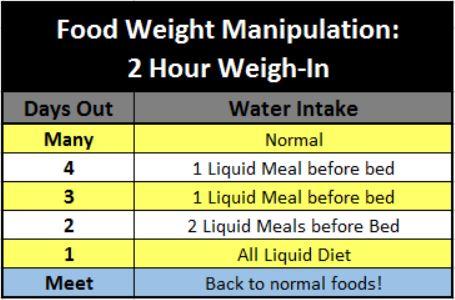
Note: Quit eating food ~12 hours before your weigh-in time.
Supplements
There are very few supplements worth a damn in this entire process, but let’s break down the categories: 1) natural diuretics, 2) natural laxatives, and 3) reconstitution support.
Natural Diuretics for Weight Cutting
A diuretic is simply something that enhances the rate at which you urinate. As far as I’m concerned, the most potent natural diuretic that won’t harm your performance is caffeine. 200mg is an effective dose for this purpose. Try to avoid PM doses that might affect your sleeping habits.
After caffeine, dandelion root is fairly effective as well.
There are a few other natural supplements that can help. If you want all of this stuff at once without having to think about it, just find the cheapest, generic water pill that you can. My favorite happens to be Watershed by Absolute Nutrition. Follow the dosing guidelines on the label.
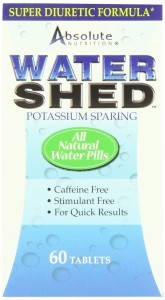
I’ve had great success with Watershed as a generic diuretic.
Additionally, if you’re at weigh-ins, and, god forbid, you’re overweight a bit, I’d recommend having some extremely sour candy on hand or a cinnamon product. Both will increase saliva production massively. From there, you can spit off the rest of the weight. This is often good for a pound or so (half a kilo). My favorite “supplement” for this is Warheads candy.
Natural Laxatives
I’m going to avoid talking about any prescription laxatives because you probably can’t and shouldn’t get your hands on them anyways. My go-to in this area has always been magnesium citrate as an oral solution. You need to keep in mind that this stuff tastes absolutely awful. It is disgusting. You’re also going to want to be near a toilet. I’m dead serious. The effects are, eh, “explosive”. However, you should be able to get it at any basic drug store. Follow the dosing guidelines on the label or until effect.
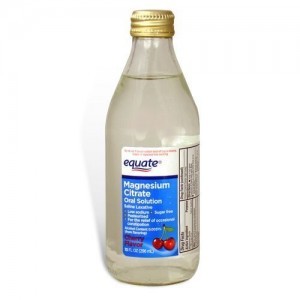
The most awful tasting, yet highly effective natural laxative that I know of is magnesium citrate.
You’re going to want to take this after your last solid meal of the week before weigh-ins. This should be on the day where you have two liquid meals. You want to do this early enough in the day that you’re not waking up all night having to go to the bathroom. You also want to do it early enough that your system is cleared out by the time you’re taking in all liquid meals.
Reconstitution Support
I’ve already made mention of the 50%/50% drinks several times but I’ll do so again here. Mix a drink with 50% water and the 50% coming from either Gatorade, pedialyte or coconut water. Mix in ~10g of BCAAs or two scoops if you’ve been using Scivation Xtend. This will help you from overdosing the electrolytes by drinking 100% Gatorade and/or not replenishing them sufficiently by drinking all water. That’s the main purpose.
Supplement Template
Supplement Template for a 24 Hour Weigh In
3 Days Out: Water Pill, Caffeine (AM/Noon), Magnesium Citrate
2 Days Out: Water Pill, Caffeine (AM/Noon)
1 Day Out, Pre Weigh-In: Have sour candy or cinnamon gum on hand if spitting is necessary
1 Day Out, Post Weigh-In: Immediately drink 32oz of your 50%/50% drink
Supplements for a 2-Hour Weigh In
2 Days Out: Water Pill, Caffeine (AM/Noon), Magnesium Citrate
1 Days Out: Water Pill, Caffeine (AM/Noon)
Meet Day, Pre Weigh-In: Have sour candy or cinnamon gum on hand if spitting is necessary
Meet Day, Post Weigh-In: Immediately drink 32oz of your 50%/50% drink
Dehydration Tactics
The most important thing that you need to understand right now is that dehydration tactics are inherently unsafe. They often involve a combination of both high temperatures and extreme dehydration. You should never attempt any dehydration method while alone. You may pass out and die. Seriously. Take the necessary precautions and contact the relevant professionals to guide you through this process if you’ve never done it before.
You’re quite literally purposefully dehydrating yourself to dangerous levels in order to lose water weight. That is what is going on here. Through the use of the sauna, a hot bath, a steam room, or whatever method you choose, you’re going to sweat enough to lose a massive amount of water weight. And then you’re not going to drink water afterwards because you have to weigh-in. This is one reason why I recommend that you keep your weight cuts under 10% at an absolute max. You won’t have to risk traveling into truly dangerous territories.
Dehydration: 2-Hour vs. 24-Hour Weigh-In
If you’re a 2-hour weigh-in competitor, I highly recommend that you just don’t try to use any of these dehydration tactics at all. You only have two hours to put water back on after the weigh-in. That isn’t enough time to fully rehydrate. Even minor dehydration has been shown to decrease performance in some athletes by up to 10%. Can you afford to lose 10% on your total? No? Then don’t try this stuff as a 2-hour weigh-in athlete.
For you 24-hour weigh-in guys, let’s get into the meat and potatoes.
The Best Way to Dehydrate
Before we can talk about the best way to rehydrate, we need to talk about the absolute madness that many people engage in when trying to cut weight. Just about the WORST thing you can do, in terms of performance and muscle maintenance, is to put on a bunch of garbage bags and run around for hours doing calisthenics. When you’re dehydrated, and under eating to make weight, you’re HIGHLY susceptible to muscle loss. The fatigue and stress you generate from using these crazy methods can cost you a MASSIVE amount of performance the next day at your meet.
With that said, in my opinion, the best method, due to its simplicity, is the sauna. You don’t have to run around and go crazy. You don’t have to put yourself in a position to lose muscle. You can just sit there, relax, and sweat. That’s it. This is why the sauna is so great.
The other option I’ve used in the past, though I consider it inferior, is to convert your bathroom into a steam room. This is sometimes necessary when you travel for a meet, have to stay at a hotel, and can’t locate a nearby sauna. In any case, you need to block the airways in the bathroom by, for example, shoving a towel underneath the door. Next, you’re going to want to get the shower running as hot as possible. Once the heat is all the way up, plug the drain in the bathtub so that a pool can accumulate. When the hot water from the shower hits the pool, steam will begin to rise. In a few minutes, this makes the bathroom quite hot. It doesn’t work as well as a sauna, but it can get the job done in a pinch.
Please keep in mind there are other options such as hot baths, but I can’t recommend these options because I’ve never used them. I strongly recommend sauna approach because it is tried and true. Weight class athletes have been using saunas effectively for decades.
Best Practices for the Sauna
First of all, let’s talk timing. You want to use the sauna as late in the game as possible because you want to know exactly how much weight you have left to take off. You should save the sauna for the early evening on the day before weigh-ins. This means you’re nearly fully depleted in terms of glycogen, you’re already a bit dehydrated due to the water and sodium loading, and your gut is empty due to the previous day’s laxatives and the current day’s liquid meals. In other words, you should already be a long ways towards making weight. This minimizes the amount of water you have to cut and it minimizes the amount of time you have to spend in such a dehydrated state.
At the same time, don’t go too late in the day because you’ll have extreme difficulty falling asleep. Your body takes quite a while to return to normal temperatures.
When it comes to actually using the sauna, I’ve personally had a lot of success with a 15 minutes in and 5 minutes out protocol. It isn’t practical, reasonable, or safe to just sit in the sauna for hours on end. Every time I get out of the sauna, I towel off any sweat that is on my skin. Once your body temperature starts to down regulate after you get into the sauna, you can actually re-absorb the sweat on your skin. I don’t want to spend any more time in the sauna than is absolutely necessary so I always towel off.
Additionally, you should keep a log of approximately how much weight you lose overnight starting ~5-7 days before your meet. This will give you a good idea of when to quit using the sauna. For me, I know from first-hand experience that I need to get within ~1.5lbs or so of making weight before I can get out of the sauna with peace of mind. I’ll lose the rest overnight. You always lose a little water weight overnight through exhalation alone. Just be careful not to cut things too close because you tend to lose a little bit less water overnight when you’re severely dehydrated.
Let’s take a look at what this all looks like in a simplified form.
Sauna Protocol
- Track how much weight you lose from night to morning during the week of the meet.
- Hit the Sauna with a guardian at ~5pm the day before weigh-ins
- 15 minutes in, 5 minutes out protocol, towel off the sweat each time
- Keep hitting the sauna until you’re well within range of losing the rest of the weight overnight.
In the end, the sauna just isn’t all that complicated. It just kind of sucks.
The EatingToWin Weight Cutting Protocol
Let’s bring all of this back together into a simple, outline form for cutting weight.
Cutting Weight For Powerlifting With A 24 Hour Weigh In
Cutting Weight For Powerlifting With A 2 Hour Weigh In
There you have it! I hope that was helpful and I hope you’re now armed to successfully cut weight for your next competition!
Did you enjoy the Powerlifting Nutrition Series?
If so, I highly recommend you check out our eBook: EatingToWin. The book contains absolutely everything you need to know about how to set up the optimal diet for YOU personally as a powerlifter, how to identify the right weight class to maximize your competitiveness, how to cut weight like a PRO so that you can drop a weight class without performance loss, and, of course, an entire section on recommended supplements with the supporting evidence behind each recommend. Grab your copy now!
Like this Article? Subscribe to our Newsletter!
If you liked this articled, and you want instant updates whenever we put out new content, including exclusive subscriber articles and videos, sign up to our Newsletter!
Questions? Comments?
For all business and personal coaching services related inqueries, please contact me:
[contact-form-7 id=”3245″ title=”Contact form 1″]
Table of Contents
Powerlifting Nutrition: How To Pick Your Weight Class
Powerlifting Diet: Cutting and Bulking
The Best Way To Measure Body Fat For Powerlifting
When To Move Up A Weight Class
How To Cut Weight For Powerlifting: 24 Hour and 2 Hour Weigh Ins
How To Diet For Powerlifting: Calories, Reverse Dieting, and More
Setting Up Your Powerlifting Macros
Meal Frequency and Nutrient Timing in Powerlifting
Eating Healthy for Powerlifting
Best Powerlifting Supplements
